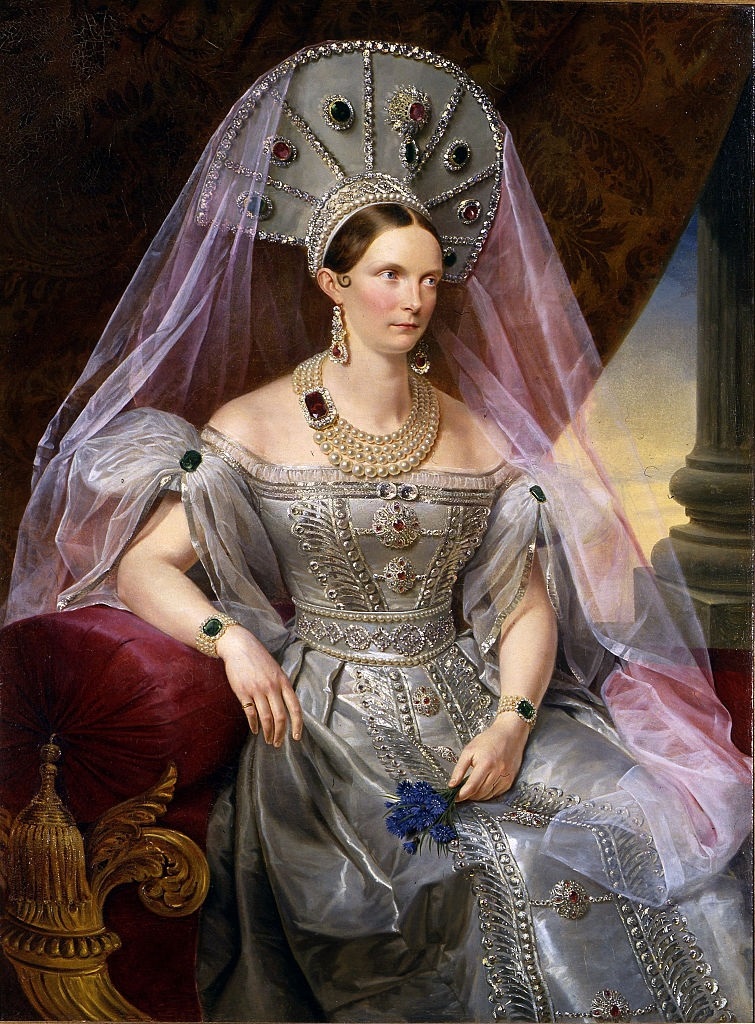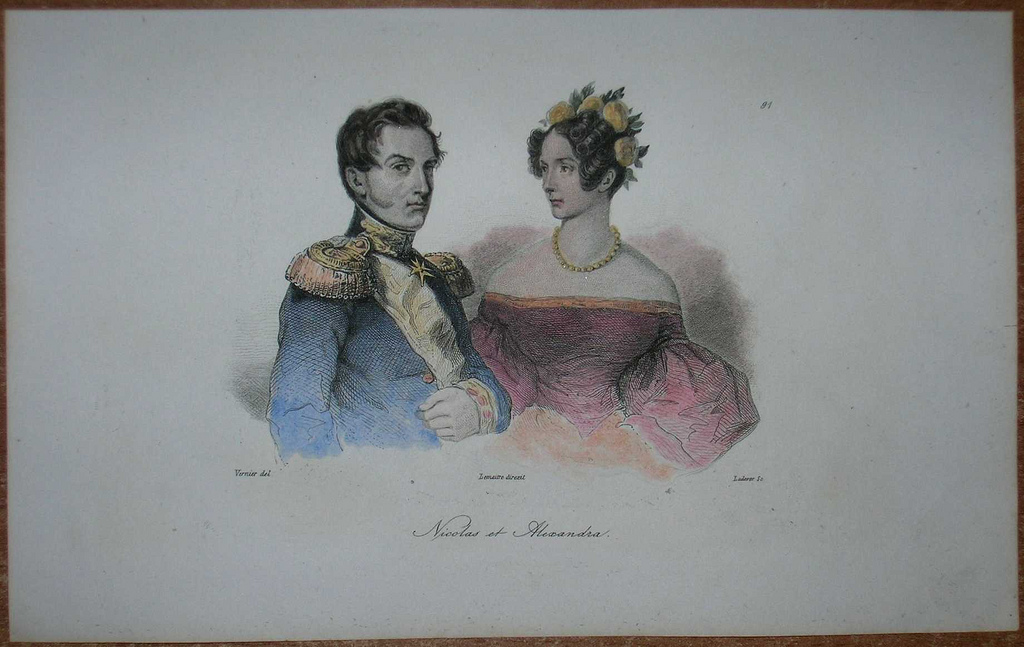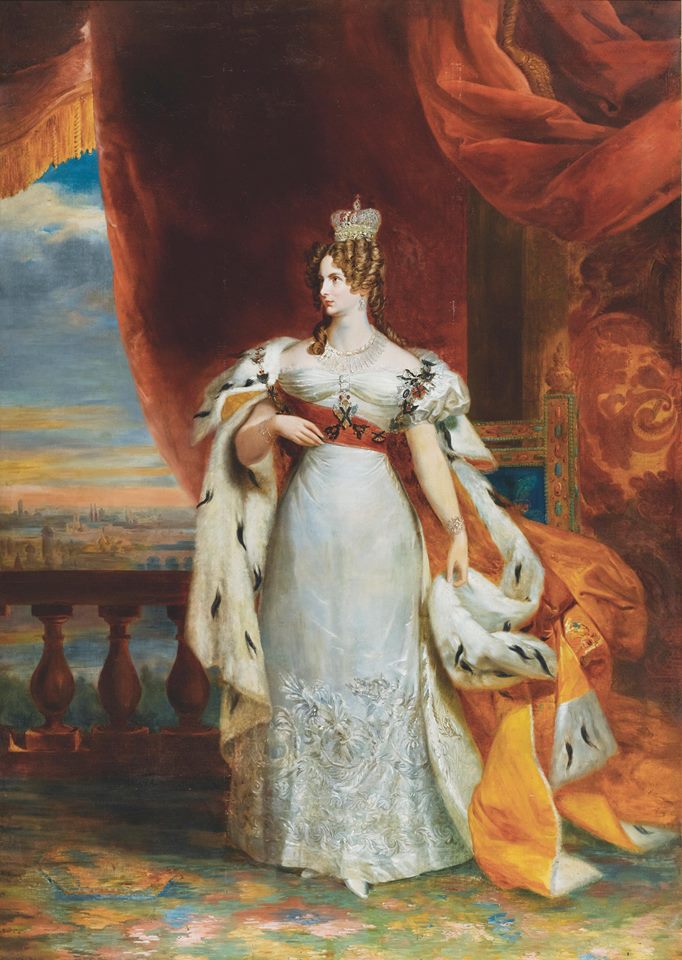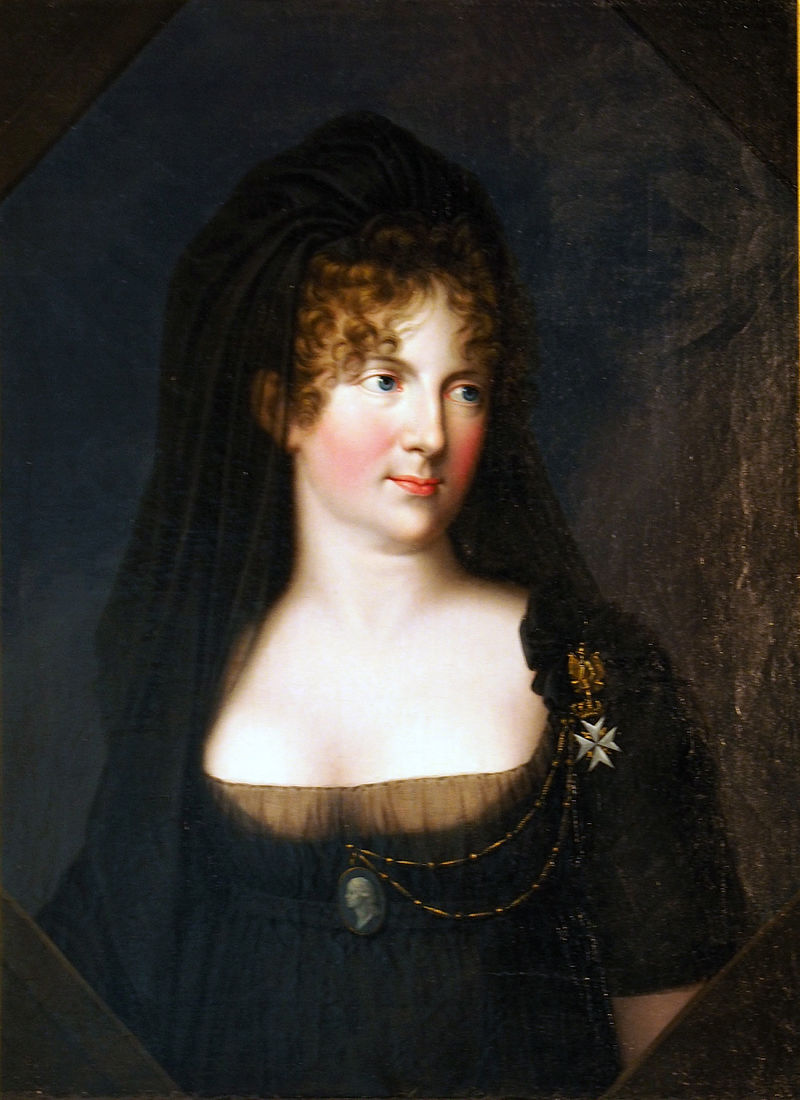by Susan Flantzer © Unofficial Royalty 2018

Marie of Mecklenburg-Schwerin, Grand Duchess Maria Pavlovna of Russia; Credit – Wikipedia
One of the few members of the Romanov family who managed to get their jewelry out of Russia after the Russian Revolution, Duchess Marie of Mecklenburg-Schwerin (Marie Alexandrine Elisabeth Eleonore) was born May 14, 1854, at Schloss Ludwigslust in Ludwiglust, Grand Duchy of Mecklenburg-Schwerin, now in the German state of Mecklenburg-Vorpommern. Marie was the only daughter and the third of the six children of Friedrich Franz II, Grand Duke of Mecklenburg-Schwerin and his first wife Augusta of Reuss-Köstritz.
Marie’s mother died at the age of 40 when Marie was eight years old. The official cause was a heart valve inflammation but there is evidence that Grand Duchess Augusta died from tuberculosis. Tuberculosis was taboo in royal circles at the time and would have reduced the marriage prospects of her children.
Marie had five siblings, all brothers:
- Friedrich Franz III, Grand Duke of Mecklenburg-Schwerin (1851 – 1897), married Grand Duchess Anastasia Mikhailovna of Russia, had three children: his father’s heir Friedrich Franz IV, Alexandrine who married King Christian X of Denmark, and Cecilie who married Wilhelm, German Crown Prince
- Duke Paul Friedrich of Mecklenburg-Schwerin (1852 – 1923), married Princess Marie of Windisch-Graetz, had four children.
- Duke Nikolaus of Mecklenburg-Schwerin (1855 – 1856), died in infancy
- Duke Johann Albrecht of Mecklenburg-Schwerin (1857 – 1920) he married (1) Princess Elisabeth Sybille of Saxe-Weimar-Eisenach, no children (2) Princess Elisabeth of Stolberg-Rossla, no children
- Duke Alexander of Mecklenburg-Schwerin (born and died 1859
Marie’s father married a second time but his wife Princess Anna of Hesse and by Rhine died shortly after giving birth to a daughter, Marie’s half-sister:
- Duchess Anna of Mecklenburg-Schwerin (1865 – 1882), died at age 16 from pneumonia
Grand Duke Friedrich Franz II married a third time in 1868 and Marie was then raised by a stepmother, Princess Marie of Schwarzburg-Rudolstadt, who was only four years older than her. Marie had four half-siblings from her father’s third marriage:
- Duchess Elisabeth Alexandrine of Mecklenburg-Schwerin (1869 – 1955), married Friedrich August II, Grand Duke of Oldenburg, had five children.
- Duke Friedrich Wilhelm of Mecklenburg-Schwerin (1871 – 1897), a naval officer in the German Imperial Navy, died at age 26 when a torpedo boat capsized in the estuary of the Elbe River
- Duke Adolf Friedrich of Mecklenburg-Schwerin (1873 – 1969), married (1) Viktoria Feodora of Reuss-Schleiz, had one daughter (2) Elisabeth of Stolberg-Rossla, no children
- Duke Heinrich of Mecklenburg-Schwerin (1876 – 1934), married Queen Wilhelmina of the Netherlands, had one daughter: Queen Juliana of the Netherlands
Marie’s childhood was marked by the wars of German unification. Her father Friedrich Franz II, Grand Duke of Mecklenburg-Schwerin was the nephew of King Wilhelm I of Prussia. Friedrich Franz supported Prussia and distinguished himself in the Franco-Prussian War of 1870 – 1871. As a result of the war, the German states proclaimed their union as the German Empire under the Prussian King Wilhelm I, finally uniting Germany as a nation-state with Wilhelm I becoming the German Emperor.

Engagement Photo: Marie and Vladimir, 1874; Credit – Wikipedia
In 1871, while traveling with his family through the various German monarchies, twenty-year-old Grand Duke Vladimir Alexandrovich of Russia, the second surviving son of Alexander II, Emperor of All Russia, met his seventeen-year-old second cousin Marie of Mecklenburg-Schwerin. The two young people were descended from Paul I, Emperor of All Russia and Friedrich Wilhelm III, King of Prussia. Vladimir and Marie quickly fell in love and Marie broke off her engagement to Georg Albert, Prince of Schwarzburg-Rudolstadt.
However, Marie, who was Lutheran, refused to convert to Russian Orthodoxy. This caused a three-year delay in the marriage until Vladimir’s father, Alexander II allowed Marie to remain Lutheran and ruled that Vladimir could still retain his succession rights. The engagement was announced in April 1874. The wedding was held at the Winter Palace in St. Petersburg, Russia on August 28, 1874, After marriage, the bride was known as Grand Duchess Maria Pavlovna.
The marriage caused Maria to have some brilliant alliances: She would be the sister-in-law of Alexander III, Emperor of All Russia and Grand Duchess Maria Alexandrovna who had married Prince Alfred of the United Kingdom, a son of Queen Victoria. She would be the aunt of Nicholas II, Emperor of All Russia and Queen Marie of Romania.
Vladimir and Maria had five children:
- Grand Duke Alexander Vladimirovich (1875 – 1877), died in early childhood
- Grand Duke Kirill Vladimirovich (1876 – 1938), married his first cousin Victoria Melita of Edinburgh and Saxe-Coburg and Gotha, had three children
- Grand Duke Boris Vladimirovich (1877 – 1943), married (1919) his mistress Zinaida Rashevskaya, no children
- Grand Duke Andrei Vladimirovich (1879 – 1956), married (1921) his mistress, the famous ballerina Matilde Kschessinskaya (known as Princess Romanovskaya-Krasinskaya after her marriage), her son Prince Vladimir Romanovsky-Krasinsky could be the son of Andrei or his cousin Grand Duke Sergei Mikhailovich
- Grand Duchess Elena Vladimirovna (1882 – 1957), married Prince Nicholas of Greece, had three daughters including Princess Marina of Greece who married Prince George, Duke of Kent, son of King George V of the United Kingdom

Vladimir, Maria, and their children, circa 1883; Credit – Wikipedia
Vladimir and Maria moved into the new 360-room Vladimir Palace on the Palace Embankment facing the Neva River just down the road from the Winter Palace in St.Petersburg. The yellow facade of the palace is in the Florentine Renaissance style and the interior is a mixture of Moorish, Gothic, and Rococo styles. It was the last imperial palace built in St. Petersburg. Across the Neva River was a view of the Peter and Paul Fortress and within the Fortress, the Peter and Paul Cathedral with its gilded spire with a flying angel at the very top. Vladimir and Maria enjoyed entertaining and Vladimir Palace became the heart of St. Petersburg’s social life. Marie was socially ambitious and established herself as one of the best hostesses in the capital. Her addiction to gambling caused her to defy Nicholas II’s prohibition on playing roulette and baccarat in private homes and she was temporarily banned from Court.

Vladimir Palace; Photo Credit – Von A.Savin (Wikimedia Commons · WikiPhotoSpace) – Eigenes Werk, CC BY-SA 3.0, https://commons.wikimedia.org/w/index.php?curid=21506331
In 1905, Maria Pavlovna’s eldest son Grand Duke Kirill Vladimirovich married his first cousin, Princess Victoria Melita of Edinburgh and Saxe-Coburg and Gotha. Victoria Melita was the daughter of Prince Alfred of the United Kingdom, Duke of Edinburgh and Duke of Saxe-Coburg and Gotha (second son of Queen Victoria) and Vladimir’s sister Grand Duchess Maria Alexandrovna of Russia. Because Kirill married his first cousin, prohibited by the Russian Orthodox Church, and because he had not received the consent of Nicholas II to marry, he was stripped of his imperial titles, military appointments, and funding. The couple was banished from Russia and settled in France. Grand Duke Vladimir went into a rage after a brief interview with his nephew Nicholas II and resigned from all his posts in the army.

Grand Duke Vladimir Alexandrovich; Credit – Wikipedia
On February 17, 1909, 61-year-old Grand Duke Vladimir Alexandrovich died suddenly after suffering a major cerebral hemorrhage. His funeral and burial, held on February 21, 1909, was attended by Nicholas II, Vladimir’s widow Grand Duchess Maria Pavlovna, other members of the Imperial Family, government ministers, and Tsar Ferdinand I of Bulgaria. Grand Duke Vladimir Alexandrovich was buried in the Grand Ducal Mausoleum, adjacent to the Peter and Paul Cathedral in St. Petersburg, Russia.
In 1909, following several deaths within the Imperial Family including Vladimir’s, Kirill was third in line to the Russian throne after Nicholas II’s hemophiliac son Alexei and Nicholas’ younger brother Michael. Nicholas II relented and allowed Kirill to return to Russia, restoring his Imperial titles, his military positions, and his funding. Maria Pavlovna finally decided to convert to Russian Orthodoxy to help Kirill’s possibility of inheriting the throne.

Maria Pavlovna with her children; Credit – Wikipedia
Maria Pavlovna was proud to have given birth to strong sons who were potential heirs to the throne, while Empress Alexandra, her niece by marriage, had four daughters before giving birth to a son with hemophilia, a hereditary disease transmitted by the Empress. Maria Pavlovna was the oldest of the Grand Duchesses and formed an alternative court during the last years of Nicholas II’s reign. Together with her sons, Maria Pavlovna planned a coup against Nicholas II during the winter of 1916-1917, which would force his abdication. However, Maria and her sons found no allies to support their coup.
After the abdication of Nicholas II in March 1917 and the advent of the Russian Revolution, Maria Pavlovna still hoped that her eldest son Kirill would one day be Emperor of All Russia. When other Romanovs were leaving Russia, including her son Kirill and his family, Maria spent 1917-1918 with her son Boris, her son Andrei, his lover Matilde Kschessinskaya, and her son Vladimir in the war-torn Caucasus. With the advance of the Bolsheviks, they fled to Anapa, Russia on the Black Sea, where they spent another fourteen months. However, Boris decided to leave Russia once he reached Anapa.
When the Commander of the White Army told Maria Pavlovna that the Bolsheviks would win the Russian Civil War, she finally agreed to go into exile. On February 13, 1920, Maria Pavlovna, her son Andrei, his mistress Matilde Kschessinska, and her son Vladimir boarded an Italian ship in the direction of Venice, Italy. They traveled from Venice to Switzerland and then to France, where Maria Pavlovna’s health failed. Grand Duchess Maria Pavlovna died on September 6, 1920, aged 66, surrounded by her family at her villa (now the Hotel La Souveraine) in Contrexéville, France.
Grand Duchess Maria Pavlovna was buried in the Chapel of St. Vladimir and St. Mary Magdalene in Contrexéville, France which she had built in 1909. Her son Andrei and his wife were also buried there.

Chapel of St. Vladimir and St. Mary Magdalene, burial place of Grand Duchess Maria Pavlovna; Photo Credit – Par Yorick Petey — Travail personnel, CC BY-SA 3.0, https://commons.wikimedia.org/w/index.php?curid=876364
Grand Duchess Maria Pavlovna had a passion for jewelry and her collection was renowned. She was one of the few members of the Romanov family who managed to get her jewelry out of Russia. British art dealer and diplomatic courier Albert Stopford, a family friend, rescued the jewelry from her Vladimir Palace safe and smuggled the jewels out of Russia to England. After Maria Pavlovna’s death, the jewelry was sold by her children to support their lives in exile. Queen Mary of the United Kingdom purchased some of the jewelry including the Vladimir Tiara. Maria Pavlovna had received the tiara as a gift from her husband at the time of their wedding. Grand Duchess Elena Vladimirovna inherited the tiara from her mother. Queen Mary bought the tiara in 1921 and had the tiara altered to accommodate fifteen of the Cambridge cabochon emeralds. The original drop pearls can easily be replaced as an alternative to the emeralds. Queen Mary personally gave the tiara to her granddaughter Queen Elizabeth II.
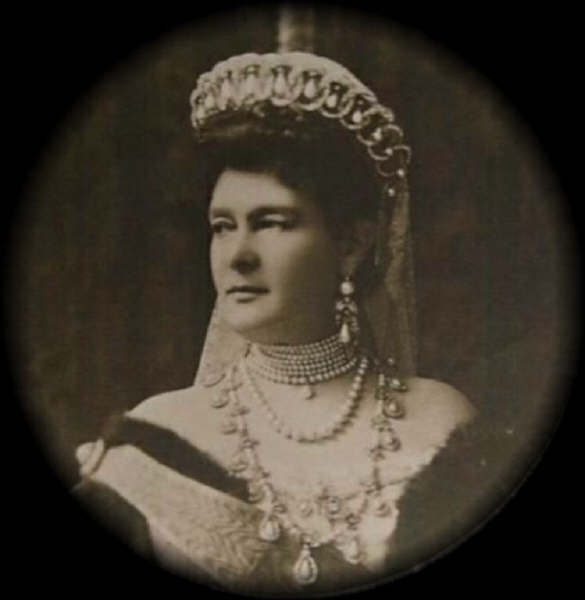
Grand Duchess Maria Pavlovna wearing the Vladimir Tiara; Credit – Wikipedia
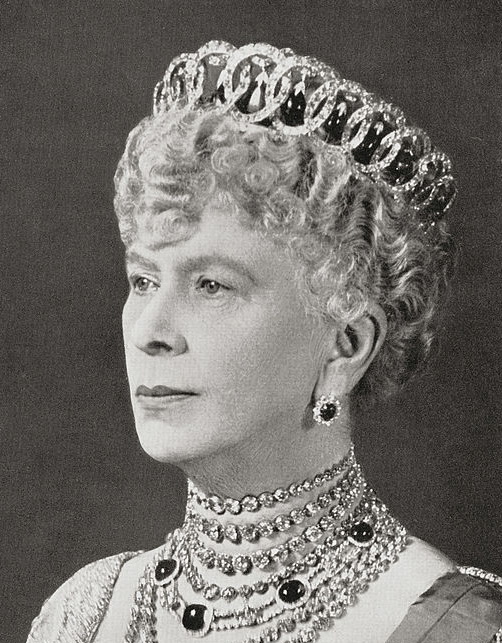
Queen Mary wearing the Vladimir Tiara; Credit – Wikipedia

Queen Elizabeth II wearing the Vladimir Tiara; Credit – Wikipedia
This article is the intellectual property of Unofficial Royalty and is NOT TO BE COPIED, EDITED, OR POSTED IN ANY FORM ON ANOTHER WEBSITE under any circumstances. It is permissible to use a link that directs to Unofficial Royalty.
Works Cited
- De.wikipedia.org. (2018). Marie zu Mecklenburg (1854–1920). [online] Available at: https://de.wikipedia.org/wiki/Marie_zu_Mecklenburg_(1854%E2%80%931920) [Accessed 25 Feb. 2018].
- En.wikipedia.org. (2018). Duchess Marie of Mecklenburg-Schwerin. [online] Available at: https://en.wikipedia.org/wiki/Duchess_Marie_of_Mecklenburg-Schwerin [Accessed 25 Feb. 2018].
- Es.wikipedia.org. (2018). María de Mecklemburgo-Schwerin. [online] Available at: https://es.wikipedia.org/wiki/Mar%C3%ADa_de_Mecklemburgo-Schwerin [Accessed 25 Feb. 2018].
- Fr.wikipedia.org. (2018). Marie de Mecklembourg-Schwerin. [online] Available at: https://fr.wikipedia.org/wiki/Marie_de_Mecklembourg-Schwerin [Accessed 25 Feb. 2018].
- Ru.wikipedia.org. (2018). Мария Павловна Мекленбург-Шверинская. [online] Available at: https://ru.wikipedia.org/wiki/%D0%9C%D0%B0%D1%80%D0%B8%D1%8F_%D0%9F%D0%B0%D0%B2%D0%BB%D0%BE%D0%B2%D0%BD%D0%B0_%D0%9C%D0%B5%D0%BA%D0%BB%D0%B5%D0%BD%D0%B1%D1%83%D1%80%D0%B3-%D0%A8%D0%B2%D0%B5%D1%80%D0%B8%D0%BD%D1%81%D0%BA%D0%B0%D1%8F [Accessed 25 Feb. 2018].




















